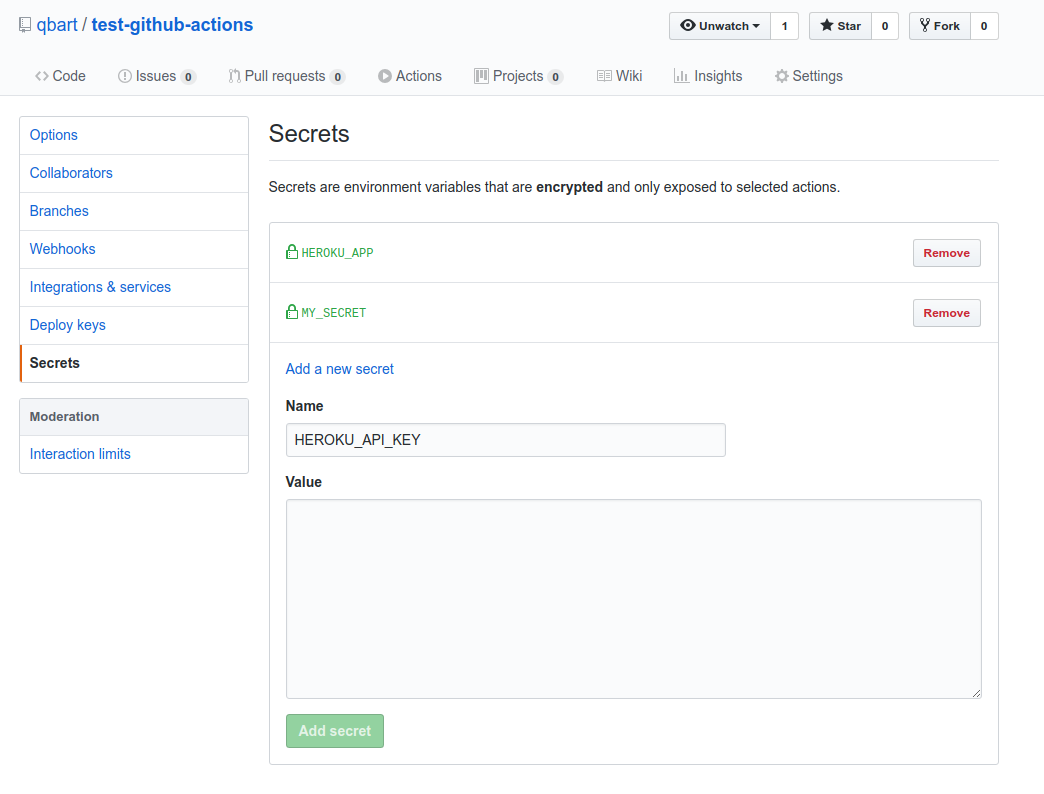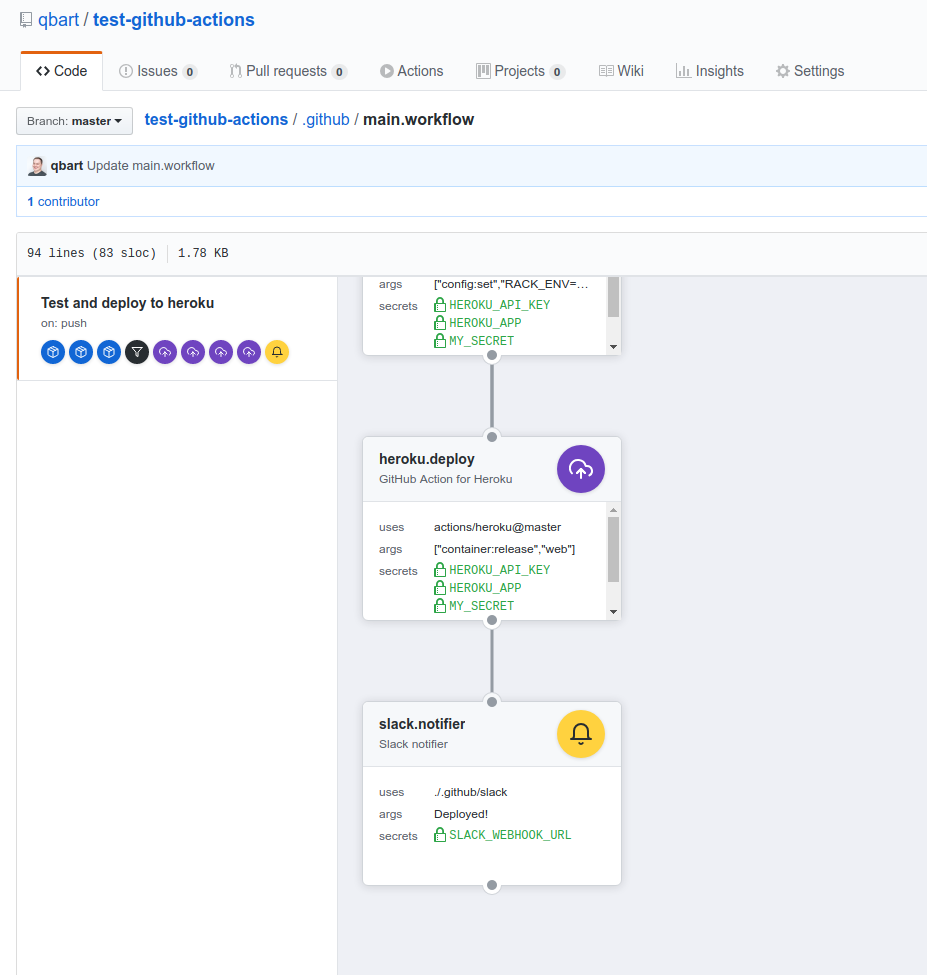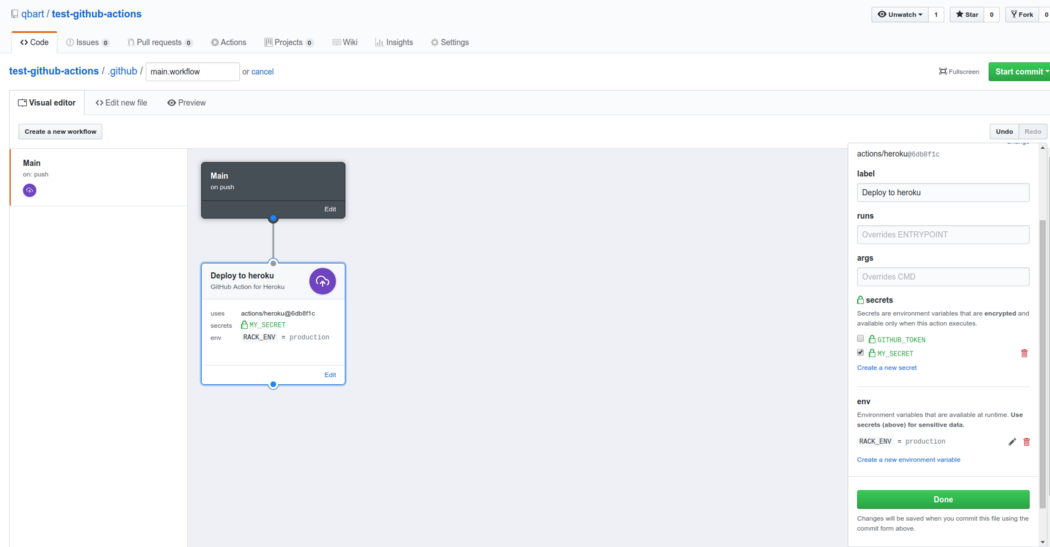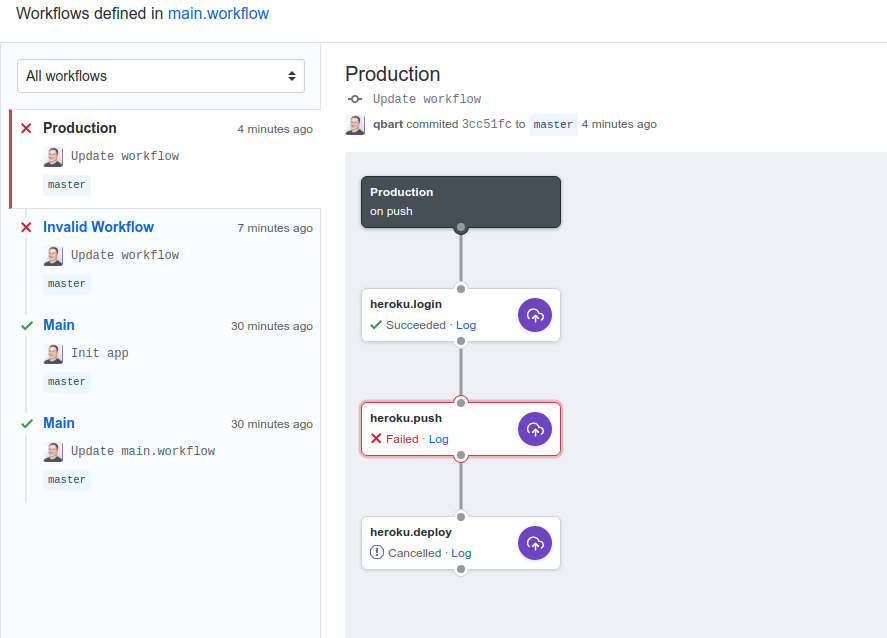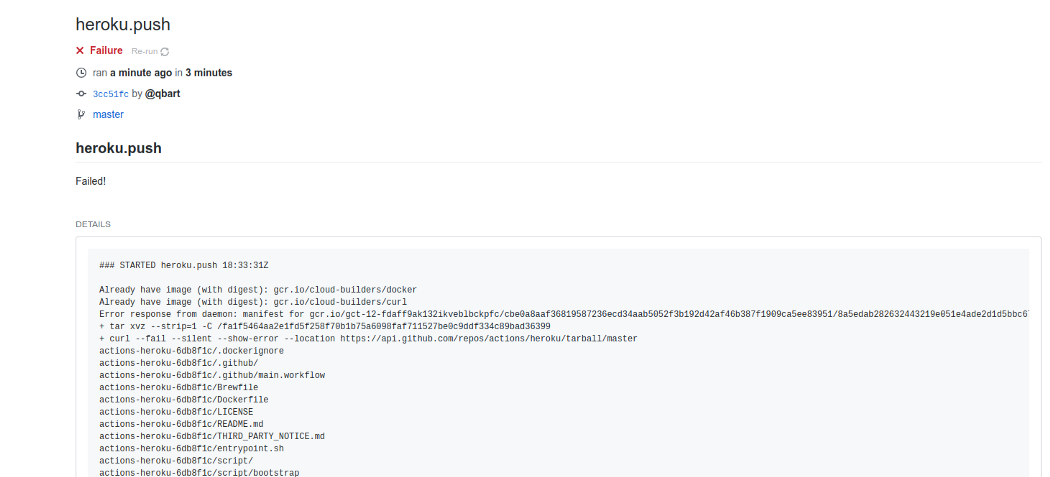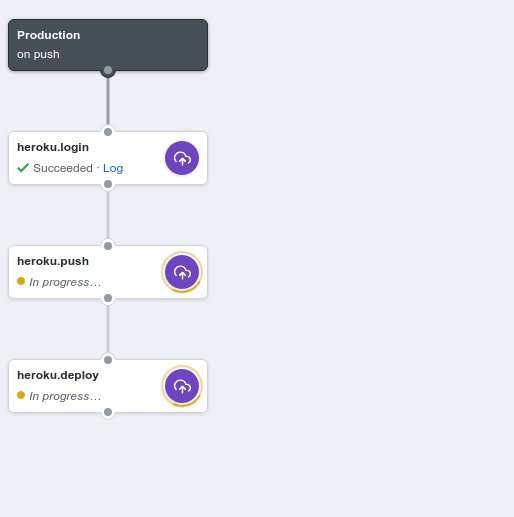Experimenting With Github Actions (beta)
This article was originally published here.
With the upcoming new GitHub Actions feature, I was very excited to test it, so I immediately signed up for the beta access and finally my invitation had been accepted.
The reason for my excitement mainly comes from my current project where I am mostly responsible for managing the infrastructure in AWS (Terraform) and backend development (Ruby on Rails) — if I have time for it. We also have a lot of PWA that we deploy to AWS Cloudfront so there is a constant need for automation (we still do some things manually but we are improving everyday). Our simplified pipeline looks like this:
- GitHub PR (master <- feature branch)
- CircleCI
- linter
- specs
- aws push to CodePipeline or trigger Cloudfront invalidation for PWA (only from master)
- AWS CodePipeline starts image building and ECS deployment
As much as I like some of the Amazon services, AWS CodePipeline is not one of them so with GitHub Actions on the rise I hope to replace it completely. To verify if that’s even possible I created a dummy project that will test the following:
- linter (rubocop)
- tests (rspec)
- deployment from master only (Heroku will do for now, I can expand that later to AWS)
- notification (when the process is done)
In this article, I won’t be going into details what GitHub Actions is and how everything works because GitHub documentation will do a much better job and I don’t want to duplicate the content that is already there, especially, that it is a beta and things might change. I will only highlight a few things and most of the time I will leave you with the link to the GitHub pages.
For the Ruby app I used Sinatra and wrote one silly endpoint:
get '/' do
"#{ENV['RACK_ENV']}: Hello there! My secret is #{ENV['MY_SECRET']}"
end
and its corresponding spec:
describe 'Test GitHub Action' do
it 'returns appropriate text for index page' do
get '/'
expect(last_response.body).to eq 'test: Hello there! My secret is 123'
end
end
For Docker, no surprises here, just a small file:
FROM ruby:2.5.1
ARG RACK_ENV
ARG PORT
ENV APP_HOME /app
RUN apt-get update -qq && apt-get install -y build-essential
RUN mkdir $APP_HOME
WORKDIR $APP_HOME
ADD . $APP_HOME/
RUN bundle install — without development test
CMD rackup -p $PORT — host 0.0.0.0
GitHub Actions come with some predefined actions built by the GitHub team. One of them is Heroku and Docker cli tools, to name a few. For more, please take a look at the documentation here.
There is also a GUI for defining actions and works pretty well but I prefer doing this in my code editor.
First, create a workflow file .github/main.workflow:
workflow "Test and deploy to Heroku" {
on = "push"
resolves = ["ruby.build"]
}
Workflow definition is pretty self-explanatory so just a short comment:
ondefines event when the whole process kicks in (push type is the only one available in beta)resolvesspecifies a list of target actions to resolve (you can put any text here but I kinda like namespace.action convention for my purposes - this comes in handy later when you declare your action dependencies)
First action:
action "ruby.build" {
uses = "actions/docker/cli@master"
args = "build -f Dockerfile.test -t ci-$GITHUB_SHA:latest ."
}
This will build a docker container that will be used for linting and testing.
Please also note that there some built-in GITHUB_* envs for you to use, list here.
Action breakdown:
usesdeclares what kind of action will it be and could be read as follows::github_user_or_org_name/:repository/:folder@:ref— as a ref I used master but for production workflows, you probably want to stick with a specific release tag or commit SHA and upgrade periodicallyargsare just arguments passed to underlying command (in this action it will bedocker ...)
Take a look here how the action repository looks like here.
Next part of the workflow can be run in parallel so:
action "ruby.rubocop" {
uses = "actions/docker/cli@master"
needs = ["ruby.build"]
args = "run ci-$GITHUB_SHA:latest rubocop"
}
action "ruby.rspec" {
uses = "actions/docker/cli@master"
needs = ["ruby.build"]
args = "run ci-$GITHUB_SHA:latest rspec"
}
Nothing new here except needs that specifies dependencies for actions (and that’s why I am using namespace.action style rather than using Build Ruby image etc., it’s just easier for me to track it with eyes).
I used a separate Dockerfile for a test environment so I can declare required variables there:
FROM ruby:2.5.1
ENV RACK_ENV test
ENV MY_SECRET 123 # if you want this to be out of the repo just use `ARG MY_SECRET` and define secrets in github action
ENV APP_HOME /app
RUN apt-get update -qq && apt-get install -y build-essential
RUN mkdir $APP_HOME
WORKDIR $APP_HOME
ADD . $APP_HOME/
RUN bundle install
Ok, so tests are running, now we want to start a deployment but only if the branch is master. There is another pre-built action for that:
action "git.master" {
uses = "actions/bin/filter@master"
needs = ["ruby.rubocop", "ruby.rspec"]
args = "branch master"
}
Before we start with Heroku workflow we need to create a project first. We will also need:
- to generate Heroku api key (
heroku authorizations:create) - to set the stack to the container based (
heroku stack:set container) - a project name (I named mine
test-github-actions)
Heroku action is described here. As of now, there is only one required secret HEROKU_API_KEY that has to contain your authorization key. You want to add this key to GitHub secrets.
action "heroku.login" {
uses = "actions/heroku@master"
needs = ["git.master"]
args = "container:login" secrets = ["HEROKU_API_KEY"]
}
secrets tells to decrypt declared variables in this action and expose them internally as an ENV (otherwise they won’t be available), also do not print them because they might remain in logs.
Once we are logged in we can push our image:
action "heroku.push" {
uses = "actions/heroku@master"
needs = "heroku.login"
args = "container:push web"
secrets = [
"HEROKU_API_KEY",
"HEROKU_APP"
]
env = {
RACK_ENV = "production"
}
}
A little more explanation here, first I used HEROKU_APP which means that container will push image to whatever app that is defined there. There are actually multiple ways of how this could be achieved:
args = "container:push -a test-github-actions web"
or
args = "container:push web"
env = {
HEROKU_APP = "test-github-actions"
}
Personally, I preferred to put in secrets here so it requires less typing later if you need to use it multiple times in different actions.
RACK_ENV = "production" is defined here as a building environment variable for docker image (our dockerfile had: ARG RACK_ENV).
For the following piece, I used heroku config:set command to propagate all my variables and secrets to heroku runtime variables:
action "heroku.envs" {
uses = "actions/heroku@master"
needs = "heroku.push"
args = [
"config:set",
"RACK_ENV=$RACK_ENV",
"MY_SECRET=$MY_SECRET"
]
secrets = [
"HEROKU_API_KEY",
"HEROKU_APP",
"MY_SECRET"
]
env = {
RACK_ENV = "production"
}
}
And finally, a deployment:
action "heroku.deploy" {
uses = "actions/heroku@master"
needs = ["heroku.envs", "heroku.push"]
args = ["container:release", "web"]
secrets = [
"HEROKU_API_KEY",
"HEROKU_APP",
"MY_SECRET"
]
env = {
RACK_ENV = "production"
}
}
At this moment, you should also update your workflow:
...
resolves = ["heroku.deploy"]
...
because that’s the action you need to resolve to.
For a cherry on the top, I would add Slack notification and for that, we will need custom action, turns out it’s easy to do this. As a starting point, replicate the following structure in your project folder:
.github/
slack/
Dockerfile
entrypoint.sh
For entrypoint.sh I defined a simple message posting to Slack:
#!/bin/sh
set -e
curl -X POST -H 'Content-type: application/json' \
--data "{\"text\": \"$*\",\"attachments\":[{\"footer\": \"$GITHUB_ACTOR / $GITHUB_REPOSITORY / $GITHUB_SHA\"}]}" \
$SLACK_WEBHOOK_URL
The important part: $* - command arguments will be pasted here. For the rest, please refer to Slack documentation.
Minimal dockerfile:
FROM debian:9.5-slim
RUN apt-get update -qq && apt-get install -y curl
ARG SLACK_WEBHOOK_URL
ARG GITHUB_ACTOR
ARG GITHUB_REPOSITORY
ARG GITHUB_SHA
LABEL "com.github.actions.name"="Slack notifier"
LABEL "com.github.actions.description"="Sends message to slack channel"
LABEL "com.github.actions.icon"="bell"
LABEL "com.github.actions.color"="yellow"
ADD entrypoint.sh /entrypoint.sh
ENTRYPOINT ["/entrypoint.sh"]
GitHub labels allow to customize the visual appearance of our action (you can see it later in GitHub workflow view). For a full customization refer to the documentation: creating-a-new-action / color list / icon list.
At the end, make sure your code is executable:
chmod +x entrypoint.sh
A final touch on workflow:
workflow "Test and deploy to heroku" {
on = "push"
resolves = ["slack.notifier"]
}
...
action "slack.notifier" {
uses = "./.github/slack"
needs = ["heroku.deploy"]
args = "Deployed!"
secrets = ["SLACK_WEBHOOK_URL"]
# GITHUB_* envs are automatically here
}
and here is the result:
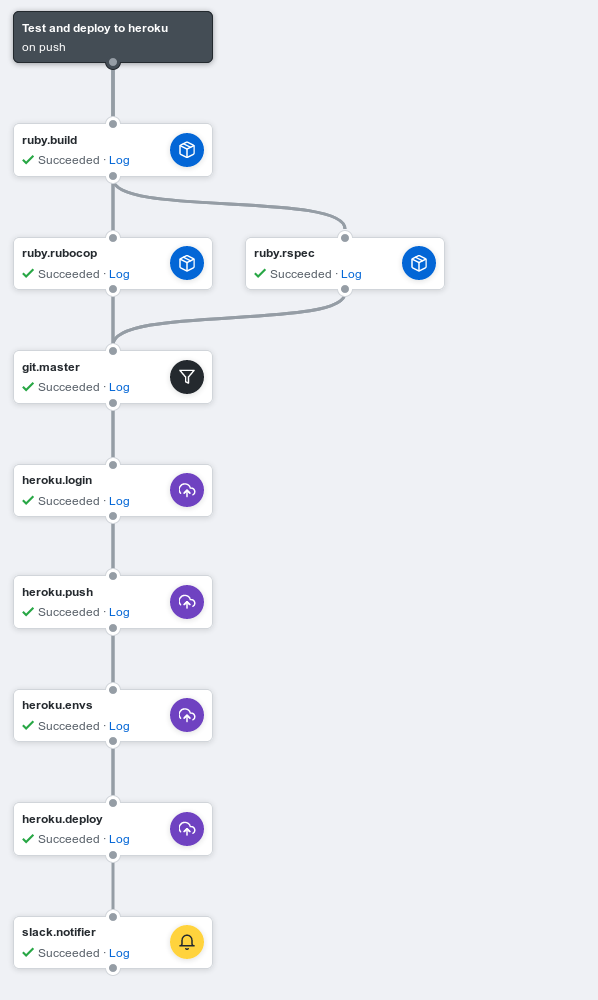
To sum it all up, I am very happy with the upcoming GitHub changes. My dummy project proved me that GitHub Actions are more than capable of replacing parts of our current pipeline and once a stable release is ready, we will plan to integrate it with our commercial project.
Link to repo: https://github.com/qbart/test-github-actions.
PS. If you find any errors in my article/code please let me know :)
And a couple of screenshots I took during the development:
